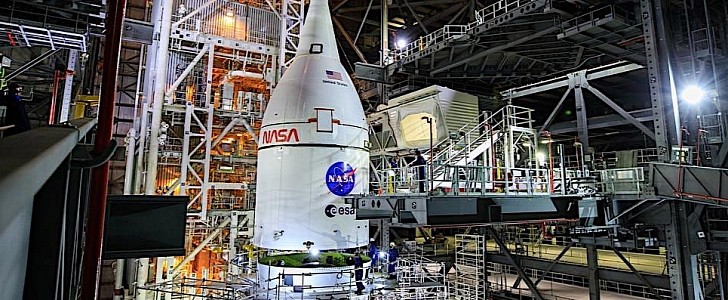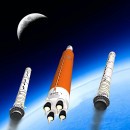For a while now, both the Space Launch System (SLS) rocket and the Orion capsule it will be sending on a trip around the Moon next year have been neatly tucked away inside the Vehicle Assembly Building (VAB) at the Kennedy Space Center in Florida, being put together by literal rocket scientists. Soon, the complete combo should be out in the open for the first time.
The American space agency does not yet have an exact date for when the rollout will occur, but says it will happen “this winter.” The huge assembly will move perched on top ofthe crawler transporter-2, and will be moved to Launch Pad 39B where an Artemis I-related test is set to take place.
Being such an important moment in the history of space exploration, the rollout will be a spectacle in itself. NASA will allow media to experience the VAB-to-pad journey first hand, “from multiple locations,” so expect tons of photos of the moment to surface online.
After it reaches the pad, the rocket will spend about a week there doing nothing. Then, NASA will feed the rocket more than 700,000 gallons of cryogenic fuel to see how the assembly copes. It will then move to simulate “the launch countdown sequence, ending prior to engine ignition.” Last but not least, procedures to drain the propellants from the rocket will be demonstrated.
Artemis I is at the time of writing scheduled for liftoff in the first months of next year (the initial plan was to have it out there by the end of this year). It’s a dry run, with the Orion carrying no astronauts aside for the Campos dummy, and there will be no landing on the Moon.
Instead, the Orion will circle the satellite one and a half times at a distance of 38,000 nautical miles, then head back and make a splashdown in the Pacific. If all goes well, humans are up next.
Being such an important moment in the history of space exploration, the rollout will be a spectacle in itself. NASA will allow media to experience the VAB-to-pad journey first hand, “from multiple locations,” so expect tons of photos of the moment to surface online.
After it reaches the pad, the rocket will spend about a week there doing nothing. Then, NASA will feed the rocket more than 700,000 gallons of cryogenic fuel to see how the assembly copes. It will then move to simulate “the launch countdown sequence, ending prior to engine ignition.” Last but not least, procedures to drain the propellants from the rocket will be demonstrated.
Artemis I is at the time of writing scheduled for liftoff in the first months of next year (the initial plan was to have it out there by the end of this year). It’s a dry run, with the Orion carrying no astronauts aside for the Campos dummy, and there will be no landing on the Moon.
Instead, the Orion will circle the satellite one and a half times at a distance of 38,000 nautical miles, then head back and make a splashdown in the Pacific. If all goes well, humans are up next.

















